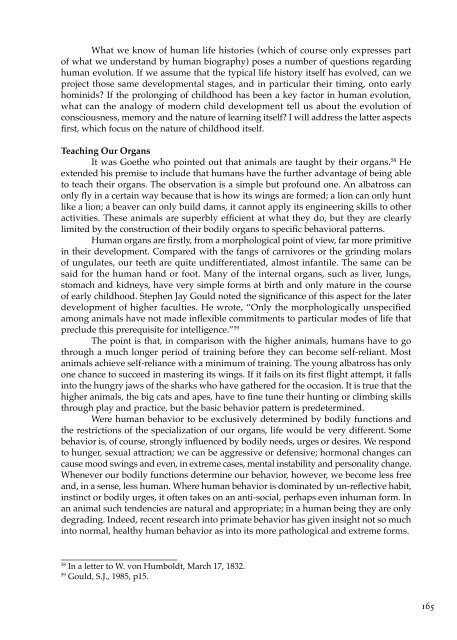The Spirit in Human Evolution - Waldorf Research Institute
The Spirit in Human Evolution - Waldorf Research Institute
The Spirit in Human Evolution - Waldorf Research Institute
Create successful ePaper yourself
Turn your PDF publications into a flip-book with our unique Google optimized e-Paper software.
What we know of human life histories (which of course only expresses part<br />
of what we understand by human biography) poses a number of questions regard<strong>in</strong>g<br />
human evolution. If we assume that the typical life history itself has evolved, can we<br />
project those same developmental stages, and <strong>in</strong> particular their tim<strong>in</strong>g, onto early<br />
hom<strong>in</strong>ids? If the prolong<strong>in</strong>g of childhood has been a key factor <strong>in</strong> human evolution,<br />
what can the analogy of modern child development tell us about the evolution of<br />
consciousness, memory and the nature of learn<strong>in</strong>g itself? I will address the latter aspects<br />
first, which focus on the nature of childhood itself.<br />
Teach<strong>in</strong>g Our Organs<br />
It was Goethe who po<strong>in</strong>ted out that animals are taught by their organs. 58 He<br />
extended his premise to <strong>in</strong>clude that humans have the further advantage of be<strong>in</strong>g able<br />
to teach their organs. <strong>The</strong> observation is a simple but profound one. An albatross can<br />
only fly <strong>in</strong> a certa<strong>in</strong> way because that is how its w<strong>in</strong>gs are formed; a lion can only hunt<br />
like a lion; a beaver can only build dams, it cannot apply its eng<strong>in</strong>eer<strong>in</strong>g skills to other<br />
activities. <strong>The</strong>se animals are superbly efficient at what they do, but they are clearly<br />
limited by the construction of their bodily organs to specific behavioral patterns.<br />
<strong>Human</strong> organs are firstly, from a morphological po<strong>in</strong>t of view, far more primitive<br />
<strong>in</strong> their development. Compared with the fangs of carnivores or the gr<strong>in</strong>d<strong>in</strong>g molars<br />
of ungulates, our teeth are quite undifferentiated, almost <strong>in</strong>fantile. <strong>The</strong> same can be<br />
said for the human hand or foot. Many of the <strong>in</strong>ternal organs, such as liver, lungs,<br />
stomach and kidneys, have very simple forms at birth and only mature <strong>in</strong> the course<br />
of early childhood. Stephen Jay Gould noted the significance of this aspect for the later<br />
development of higher faculties. He wrote, “Only the morphologically unspecified<br />
among animals have not made <strong>in</strong>flexible commitments to particular modes of life that<br />
preclude this prerequisite for <strong>in</strong>telligence.” 59<br />
<strong>The</strong> po<strong>in</strong>t is that, <strong>in</strong> comparison with the higher animals, humans have to go<br />
through a much longer period of tra<strong>in</strong><strong>in</strong>g before they can become self-reliant. Most<br />
animals achieve self-reliance with a m<strong>in</strong>imum of tra<strong>in</strong><strong>in</strong>g. <strong>The</strong> young albatross has only<br />
one chance to succeed <strong>in</strong> master<strong>in</strong>g its w<strong>in</strong>gs. If it fails on its first flight attempt, it falls<br />
<strong>in</strong>to the hungry jaws of the sharks who have gathered for the occasion. It is true that the<br />
higher animals, the big cats and apes, have to f<strong>in</strong>e tune their hunt<strong>in</strong>g or climb<strong>in</strong>g skills<br />
through play and practice, but the basic behavior pattern is predeterm<strong>in</strong>ed.<br />
Were human behavior to be exclusively determ<strong>in</strong>ed by bodily functions and<br />
the restrictions of the specialization of our organs, life would be very different. Some<br />
behavior is, of course, strongly <strong>in</strong>fluenced by bodily needs, urges or desires. We respond<br />
to hunger, sexual attraction; we can be aggressive or defensive; hormonal changes can<br />
cause mood sw<strong>in</strong>gs and even, <strong>in</strong> extreme cases, mental <strong>in</strong>stability and personality change.<br />
Whenever our bodily functions determ<strong>in</strong>e our behavior, however, we become less free<br />
and, <strong>in</strong> a sense, less human. Where human behavior is dom<strong>in</strong>ated by un-reflective habit,<br />
<strong>in</strong>st<strong>in</strong>ct or bodily urges, it often takes on an anti-social, perhaps even <strong>in</strong>human form. In<br />
an animal such tendencies are natural and appropriate; <strong>in</strong> a human be<strong>in</strong>g they are only<br />
degrad<strong>in</strong>g. Indeed, recent research <strong>in</strong>to primate behavior has given <strong>in</strong>sight not so much<br />
<strong>in</strong>to normal, healthy human behavior as <strong>in</strong>to its more pathological and extreme forms.<br />
_________________________<br />
58<br />
In a letter to W. von Humboldt, March 17, 1832.<br />
59<br />
Gould, S.J., 1985, p15.<br />
165
















